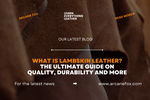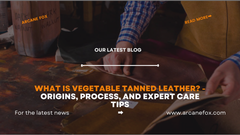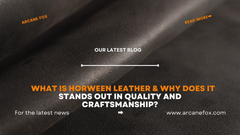What is Exotic Leather? Origins, Types, Care, and more

What is Exotic Leather? Origins, Types, Care, and more
We obtain leather hides from about 50 of the more than 5000 mammal species. Animals that are raised for meat or dairy consumption are used to produce and prepare leather.
Cows, water buffalo, goats, and pigs' hides are used to make leather, but they are also bought to make by-products. What precisely are exotic leather hides, then? Leather is made from the skins of animals, primarily reptiles, that are only hunted for their hides, as opposed to animals that have already been killed for food.
1. Exotic Leather Origins

Exotic leather sources are those that come from animal breeds other than cows. The Convention on International Trade in Endangered Species of Wild Fauna and Flora protects exotic leather. Leather that is special and distinctive in nature may also be found. This category includes leather made from fish, cow belly, and chicken legs.
2. What is called exotic leather?
Exotic skins include an exquisite array of materials such as Python, Iguana, Tejus, Ostrich, Stingray, Crocodile, Alligator, and Shark skins - distinguished from conventional leather by their rarity, unique textures, and exquisite aesthetics.
Each exotic skin offers its own special charms. Python boasts intricate patterns while Ostrich features quill-like markings. Crocodile scales also stand out among them all as an iconic reminder of this creature's prehistoric origins. Their exotic qualities set these prized hides apart from standard leather, emphasizing their exceptional nature.
Their superior materials have long been sought-after by fashion and luxury industries for adding an additional element of opulence and sophistication to high-end products, from handbags to footwear, that symbolize both natural beauty and craftsmanship in harmony.
3. Is Exotic Leather Better Than Other Types Of Leather?

Any leather form is not subject to any standards. While some leather surfaces tend to be softer, mattifying, and charmingly distinct in color, others are slimier or more abrasive. The requirement for the majority of the leather is met by the cattle, which provide 90% of the meat (goatskin, cowhide, sheepskin, etc.). Exotic leather is so infrequently used, which increases its allure and buzz.
In fact, improvements have been made recently to turn vinyl leatherette into man-made leather. Exotic leather hides may or may not be superior to conventional leather in terms of toughness, quality, or durability.
Alligator leather Antelope leather Armadillo leather
Bird leather Caiman leather Camel leather
Carpincho leather Cat fur Chicken leather
Crocodile leather Dog leather Donkey leather
Elephant leather Fish leather Toad leather
Giraffe leather Hippo Leather Horsehide
Kangaroo leather Llama Fur Lizard leather
Ostrich leather Pangolin leather Peccary leather
Rumen leather Sealskin leather Snakeskin
Turtle skin Walrus leather Yak leather
Zebra hide Alpaca fur
4. Types of Exotic Leather

There are various varieties of exotic leather available around the world. The top exotic leathers are listed below, along with information on their characteristics.
4.1 American Alligator Leather
Alligator leather comes with a scaly texture and surface, and its hide is stronger than cowhide but the same in terms of durability. The leather extracted from an alligator's belly is gorgeous-looking with a lot of flexibility. To extract the softest hides, the gullet of the alligator is deemed best. The alligator leather comes in numerous finishes and colors. Usually, alligator leather is used in producing wallets.
4.2 Elephant Leather
Elephant hides are currently completely lawful to buy and use, despite the fact that elephant leather may appear to be forbidden. One of the hardest leathers available, elephant leather can have a texture that ranges from being slightly dense and rough to even having wrinkles. As for colors available to you, they range from earthy hues to deep black.
4.3 Hippo Leather
Hippo leather is one of the softest hides you will find, boasting an irresistibly peach-like texture due to time spent submerged in water. Additionally, this waterproof leather easily repels rain as cowhide does; brown and jet-black varieties of this leather are available, although its price may be higher.
4.4 Ostrich Leather
Ostrich leather boasts an exceptional texture. The iconic quill bumps of this material are evenly spaced across its entirety, creating an almost tactile experience when touching this hide on your hands. Ostrich leather comes in various shades, including pure white, blue, tan brown, and black; in fact, the knee leather from an ostrich is often considered among the highest quality available due to its strength; it even comes with its own distinctive lizard-scaling pattern.
4.5 Python Leather
There are two types of python leather available that come from snakes: Reticulated Python Leather and Karung Snake Leather. These varieties have a scaling pattern, as well as being smooth to the touch, making this kind of material highly desirable for leather products. Where you extract it will determine its visibility.
An example of leather extracted from the belly or back has a diamond-like pattern, is darker, and is found on white or coffee-colored hides. Karung skins come with fine scales in two tones, with two tones having more flexibility and come with beige-hued colors.
4.6 Giraffe Leather
Tanning procedures used on giraffe skin help eliminate block prints, creating durable and dense pieces with stunning patterns that appear dense when touched. Giraffe leather comes in both tan and gray colors for classy and elegant products.
4.7 Stingray Leather
Stingray leather resembles glass beads in terms of its material and texture, similar to fingernail skin; translucent. The hide can be dye in various shades and tones; its translucent nature lends it to brighter products due to the texture; real stingray leather is capable of reflecting light, especially black stingray leather, which weighs more than other types. Stingray leather also stands up well under pressure compared to any other form of leather and provides strength without weight penalties.
4.8 Real Leather vs Exotic Leather
Leather can come in many varieties and variations; exotic is one of them. Real leather is soft and flexible with an inherent warmth and grainy feel that gives off an oaky scent; most real leather comes from cattle; cowhide, sheepskin, and calfskin are often extracted as sources for its material. More luxurious options may also exist, such as exotic leather from elephants, alligators, snakeskin, etc.
4.9 Bison Leather vs Cowhide Leather
Since the animal is almost extinct, bison leather is exotic and uncommon. It is tough and resilient, yet more inflexible than cowhide leather. The primary disadvantage of bison leather is its lack of flexibility when compared to the toughness and thickness of cowhide.
5. Pros and Cons of Exotic Leather
5.1 The Cons of Exotic Leather
One of the primary concerns of exotic leather production, such as alligator leather, is that its production is unsustainable. Tanneries often generate waste such as dead animal carcasses that have an adverse impact on groundwater quality and agricultural habitats, leading to huge, unhealthy production volumes with potentially negative consequences for environmental sustainability.
5.2 The Pros of Exotic Leather
Exotic leathers have long been prize for their extraordinary longevity and resilience, making them an appealing investment option. Unlike other materials, exotic leather naturally resists wear and tear over time to maintain its quality and value over time - an advantage that increases its investment potential significantly. With proper care, items crafted with exotic leather may even remain beautiful for decades while keeping their value and original allure intact, adding to their investment potential further.
6. How Exotic Leather is Made?
Exotic Leather refers to hides derived from animals - most often reptiles - that are specifically hunted and harvested for their skins, in order to produce leather goods, unlike cattle which are consumed before later being used to create such goods.
7. What are the popular uses of exotic leather?
Exotic leather from animals such as Pythons, Iguana, Tejus, Ostrich, Stingrays, Crocodile Alligators Shark serves a range of applications across industries due to its distinctive textures and durability. Fashion industries widely utilize exotic leather in high-end accessories like handbags, wallets, belts and shoes to give these pieces a sense of exclusivity and prestige.
Exotic leather also enhances both looks and quality in high-end apparel, auto interiors, furniture, and home accents. It also graces businesses like those for musical instruments, guns, and golf accessories, where grandeur and functionality coexist. Beyond these, it improves artisanal goods, luxury baggage, and artwork, but ethical sourcing and responsible practices are still crucial to the survival of the exotic leather business.
8. Exotic Leather Care and Maintenance

8.1 How to Clean Exotic Leather?
When it comes to maintaining exotic leathers it is always common sense. Clean them if they become soiled. Even if they don't appear visibly dirty, clean them again after a few months if they haven't been touch up. Leather breathes in the grime that accumulates on it since it is a living material. Would you like to go a month without washing and roll around in a layer of dust? Dirt and debris may become trapped inside the pores of your leather if you don't properly clean it before conditioning it. However, if your exotic leather purse is already reasonably clean and merely requires routine maintenance, this step might not be require.
As some leather cleaners and leather conditioners might have unpredictable effects depending on the material they are use on, make sure you have the right leather cleaner to use on your wallet or shoes before you begin. Preferably, this cleaner is made expressly for cleaning exotic leather. Avoid using leather cleansers with alcohol as alcohol has a tendency to dry out exotic leather more severely than leather made from cows.
Pretesting your cleaner in a covert, discrete area before using it all over the piece is a good approach to make sure it's the appropriate one for you. Don't use the cleaning product or accept that there may be some modification to the leather if, after an hour, the color of the leather changes or you notice coloration on the cloth.
- When you have pretested, your exotic leather is ready for cleaning.
- Scatter a little leather cleaner over the surface.
- Use a clean cloth to gently rub it in circular motions.
- Keep going up until you've cleaned the whole thing.
- To complete, wipe the object completely with a clean cloth.
8.2 How to Condition Exotic Leather?
It's time to condition your leather after you've finished using the leather cleaner. To finish the conditioning process, you will follow similar procedures, with the exception that you will need to apply a mild conditioner designed for exotic leather to avoid making its delicate skin too oily. Once you're prepared:
- Use a clean cloth and a small bit of leather conditioner.
- Apply circular motions to the leather as you rub.
- After giving the leather enough time to dry, use a soft, dry towel to polish it.
Additionally, it's crucial to store your exotic leathers with additional caution. To help them maintain their shape and beauty, they should ideally be store in a cool, dry environment. Even if you don't use your exotic leather item for a while, you should nevertheless clean and condition it carefully every few months to guarantee its long-term life.
Grab your compass and machete with confidence and attack the woods without hesitation now that you have mastered that snake skin polish and put the fire back in your ostrich leather duffel. Your back is cover by your leather pack.
9. Conclusion
In order to sum up this discussion, exotic leather is pricey and comes from exotic animals. It frequently has a matte finish and a slimy appearance. Additionally, some of them have scales. The most popular items made from exotic leather include wallets, belts, jackets, and watch straps.
Learn more about leather here Leather 101 - The Ultimate Guide to Different Types of Leather
Related Posts:
-
What is Cowhide Leather? Origins, Types, and Maintenance
- What is Goatskin Leather? Different Types of Goatskin, Quality, Durability and More
-
What is Sheepskin Leather? Everything You Need To Know
- What is Lambskin Leather? The Ultimate Guide on Quality, Durability and More
- What is Calfskin Leather? It's Quality & Durability Against Other Leather!
- What Is Shearling Leather? The Truth No One Told You About This Luxe Material






